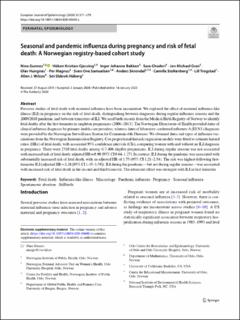| dc.contributor.author | Gunnes, Nina | |
| dc.contributor.author | Gjessing, Håkon K. | |
| dc.contributor.author | Bakken, Inger Johanne Landsjøåsen | |
| dc.contributor.author | Ghaderi, Sara | |
| dc.contributor.author | Gran, Jon Michael | |
| dc.contributor.author | Hungnes, Olav | |
| dc.contributor.author | Magnus, Per | |
| dc.contributor.author | Samuelsen, Sven Ove | |
| dc.contributor.author | Skrondal, Anders | |
| dc.contributor.author | Stoltenberg, Camilla | |
| dc.contributor.author | Trogstad, Lill | |
| dc.contributor.author | Wilcox, Allen James | |
| dc.contributor.author | Håberg, Siri Eldevik | |
| dc.date.accessioned | 2021-01-13T09:54:56Z | |
| dc.date.available | 2021-01-13T09:54:56Z | |
| dc.date.created | 2020-03-06T11:29:51Z | |
| dc.date.issued | 2020 | |
| dc.Published | European Journal of Epidemiology (EJE). 2020, 35, 371–379. | en_US |
| dc.identifier.issn | 0393-2990 | |
| dc.identifier.uri | https://hdl.handle.net/11250/2722727 | |
| dc.description.abstract | Previous studies of fetal death with maternal influenza have been inconsistent. We explored the effect of maternal influenza-like illness (ILI) in pregnancy on the risk of fetal death, distinguishing between diagnoses during regular influenza seasons and the 2009/2010 pandemic and between trimesters of ILI. We used birth records from the Medical Birth Registry of Norway to identify fetal deaths after the first trimester in singleton pregnancies (2006–2013). The Norwegian Directorate of Health provided dates of clinical influenza diagnoses by primary-health-care providers, whereas dates of laboratory-confirmed influenza A (H1N1) diagnoses were provided by the Norwegian Surveillance System for Communicable Diseases. We obtained dates and types of influenza vaccinations from the Norwegian Immunisation Registry. Cox proportional-hazards regression models were fitted to estimate hazard ratios (HRs) of fetal death, with associated 95% confidence intervals (CIs), comparing women with and without an ILI diagnosis in pregnancy. There were 2510 fetal deaths among 417,406 eligible pregnancies. ILI during regular seasons was not associated with increased risk of fetal death: adjusted HR = 0.90 (95% CI 0.64–1.27). In contrast, ILI during the pandemic was associated with substantially increased risk of fetal death, with an adjusted HR of 1.75 (95% CI 1.21–2.54). The risk was highest following first-trimester ILI (adjusted HR = 2.28 [95% CI 1.45–3.59]). ILI during the pandemic—but not during regular seasons—was associated with increased risk of fetal death in the second and third trimester. The estimated effect was strongest with ILI in first trimester. | en_US |
| dc.language.iso | eng | en_US |
| dc.publisher | Springer | en_US |
| dc.rights | Navngivelse 4.0 Internasjonal | * |
| dc.rights.uri | http://creativecommons.org/licenses/by/4.0/deed.no | * |
| dc.title | Seasonal and pandemic influenza during pregnancy and risk of fetal death: A Norwegian registry‑based cohort study | en_US |
| dc.type | Journal article | en_US |
| dc.type | Peer reviewed | en_US |
| dc.description.version | publishedVersion | en_US |
| dc.rights.holder | Copyright The Authors 2020 | en_US |
| cristin.ispublished | true | |
| cristin.fulltext | original | |
| cristin.qualitycode | 2 | |
| dc.identifier.doi | 10.1007/s10654-020-00600-z | |
| dc.identifier.cristin | 1800096 | |
| dc.source.journal | European Journal of Epidemiology (EJE) | en_US |
| dc.source.40 | 35 | en_US |
| dc.source.pagenumber | 371–379 | en_US |

